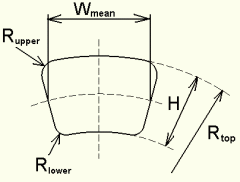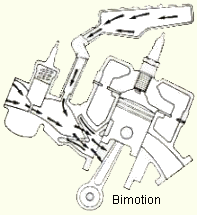|
.
 Current version: 3.2.2
Current version: 3.2.2
|
|
German and English manual available at the bottom !
This text based software covers time-area calculations of all intake
types.
The time-area (a measure of flow capability) can be varied against
port/piston/reed/disc dimensions and rpm. The specific time-area target
is calculated from desired maximum horse power (or Braked Mean Efficient
Pressure (BMEP) or kW) and corresponding crank speed and is a measure of
the ports time-area divided by the engine displacement, ms*mm^2/cc.
(milliseconds*mm^2/cc).
It also calculates the Yamaha Energy Induction System (YEIS) which is
also known as the magic boost bottle. At some engine configurations this
box will remove low rpm flat spots and/or increase the power in the low
rpm range.
A brief presentation is shown below.
More details and print outs are found in the Bimotion Intake Manual at
the bottom of this page.
|
|
System requirement: DOS 32 bit systems (all DOS 32 bit Windows OS including
Vista)
For other
newer platforms as Win 7 - Win 10, MAC, etc., you need to be an
experienced pc user to install and configure a GW-Basic emulator.
Additional installation is needed of the external program PC-Basic
following a special configuration in accordance with instructions here:
PC-Basic
configuration.
PC-Basic is an emulator
that will run the Bimotion Intake program on these platforms.
Before buying, you can make an installation of
a small Bimotion Intake test program. If you manage to configure it to
run, then the sharp Bimotion Intake program will do the same. Download
the installation file
Bimotion_Intake_Test.exe, run it and follow the instructions for
configuration. |
This is a
short demonstration about how the Bimotion Intake interface looks like: |
 |
First, Time-Area targets
will decide how much flow is needed for a specific tuning degree and
rpm. Example:
Tuned crank speed [rpm] ? 11000
Target Bmep(bar)
---------------------
Road racing >11
Motocross 9
Enduro 8
--------------------
Enter
your targets in hp .... (1)
kW .... (2)
Bmep.. (3)
hp target _?
If the target becomes 16
units then... |
|

Maximum piston skirt length: ? 58
Minimum piston skirt length: ? 50
Increment: ? 1
Recommended sp. t-a 15-20 ms-sq mm/cc
Length,mm s-sq mm ms-sq mm/cc
58 1.1 14.9
57 1.14 15.6
56 1.18 16.2
55 1.21 16.9
54 1.25 17.5
53 1.29 18.2
52 1.33 18.9
51 1.37 19.6
Enter required length: _?
|
...the port (or flow) is obviously too
large in this example. It does not
meet the target at 10000 rpm and will nor pull below 6000 rpm as seen in
the list below. (t-a over 30)
The port dimensions need to get a
correct range of time-area within the rpm range.
Specific t-a >30 => bad effect.
Crank Time-area Sp t-a
rev/min s-sq mm ms-sq mm/cc
4000 2.82 48.5
5000 2.26 38.8
6000 1.88 32.3
7000 1.61 27.7
8000 1.41 24.3
9000 1.25 21.6
10000 1.13 19.4
End of list.
The procedure is the same for all intake types.
The port and piston
dimensions can be varied against time-area at the specific rpm, as in
the left example.
If 56 mm skirt
length also meets the port duration requirement then it's ok, otherwise
the port have to be wider instead. There are also difference in working
with the piston skirt/port lower edge/port upper edge/port width. Either
is the area affected or the duration or both. This effect is easily
tested in the program and must be conformed. |
|

Previous values appear in
front of the input and are accepted by enter. |
Rotary valve input example:
Accept
by enter.
-----------------------------
Port
top radius, ... 50 _?
Port
height, ....... 18
Port
mean width, ... 22
Port
upper radii, .. 4
Port
lower radii, .. 3
Disc
opens, deg .... 120
Disc
closes, deg ... 65
 |
|

The program calculates reed
petal resonance frequency and a lot more of measures. Warnings are sent
when the specifications are out of the limits. Example:
Warning!
Tip lift is higher than stop plate height.
Reed plate is close to natural freq.(18 %)
Petal resonance frequency is crucial, if the resonance
frequency is too close to the operational rpm range then the petal will
be overloaded and fail from fatigue.
|
Reed valve input example:
Accept by enter.
Block dimensions.
-----------------------------
No
of ports ...... (6) _?
Width, ........ Xp (19.6)
Length,
....... Lp (32)
Radii, ........ Rp (1)
Angle, ..... Fi_Rb (23.5)
Reed petal dimensionsionsions
-----------------------------
Width, mm ..... Xr (22.7)_?
Length, mm .... Lr (38)
Mount distance, Xs (4)
Thickness, mm . Xt (.42)
Reed
mtrl, (C)Carbon
(G)Glass
(S)Steel (Glass)
Duration (170-210), Default 200 (200)
xtip/Lr max, % .... Default 30% (30)
 |
|
 |
A boost bottle must be
calculated exactly to the specific engine. There is no working ”one fit
all” bottle as can be found at many dealers. The function is dependent
on engine size, carb dimension, bottle volume, branch pipe dimensions,
rpm and can be optimized within a certain rpm range. The bottle and pipe
must be manufactured from a stiff material.
 |
|
Download the user manual
by clicking a flag !
|
Buy now !
Fast delivery
by e-mail
|
US $ :49.00
Order is to be placed from
Contact in the menu.

|
|
|
.